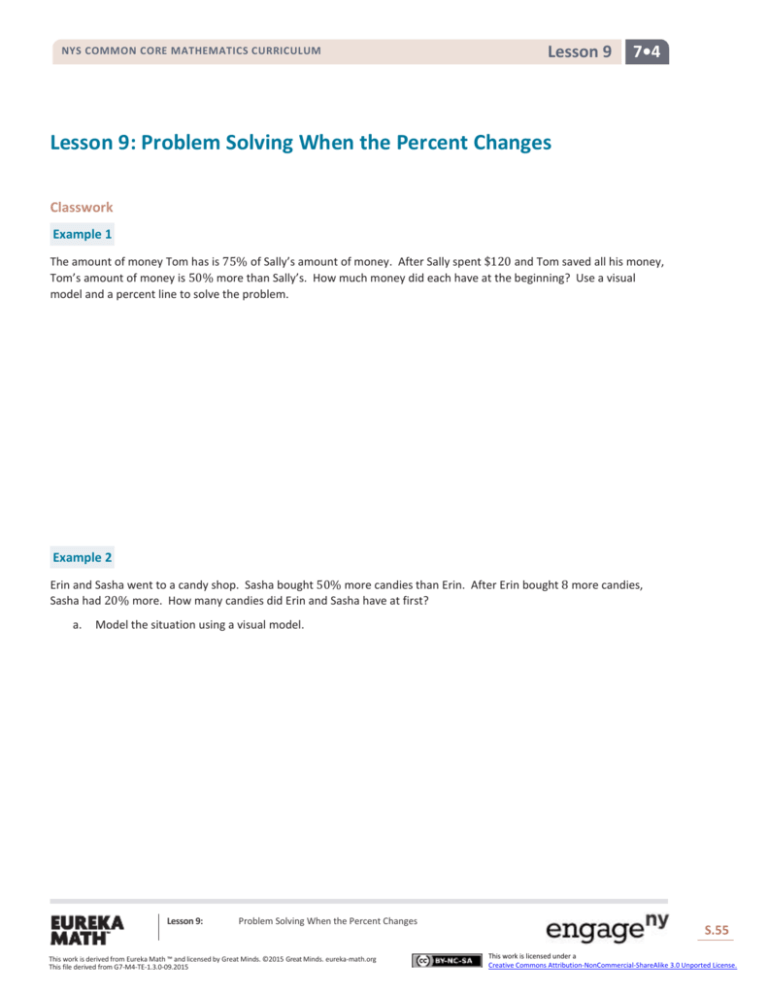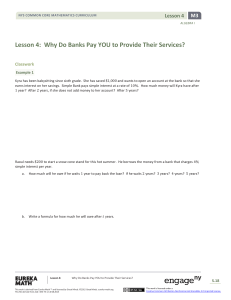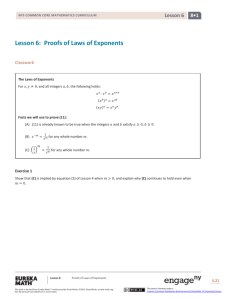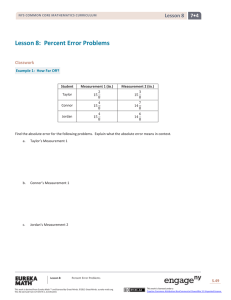Grade 7 Mathematics Module 4, Topic B, Lesson 9
advertisement

NYS COMMON CORE MATHEMATICS CURRICULUM Lesson 9 7•4 Lesson 9: Problem Solving When the Percent Changes Classwork Example 1 The amount of money Tom has is 75% of Sally’s amount of money. After Sally spent $120 and Tom saved all his money, Tom’s amount of money is 50% more than Sally’s. How much money did each have at the beginning? Use a visual model and a percent line to solve the problem. Example 2 Erin and Sasha went to a candy shop. Sasha bought 50% more candies than Erin. After Erin bought 8 more candies, Sasha had 20% more. How many candies did Erin and Sasha have at first? a. Model the situation using a visual model. Lesson 9: Problem Solving When the Percent Changes This work is derived from Eureka Math ™ and licensed by Great Minds. ©2015 Great Minds. eureka-math.org This file derived from G7-M4-TE-1.3.0-09.2015 S.55 This work is licensed under a Creative Commons Attribution-NonCommercial-ShareAlike 3.0 Unported License. NYS COMMON CORE MATHEMATICS CURRICULUM b. Lesson 9 7•4 How many candies did Erin have at first? Explain. Example 3 Kimberly and Mike have an equal amount of money. After Kimberly spent $50 and Mike spent $25, Mike’s money is 50% more than Kimberly’s. How much did Kimberly and Mike have at first? a. Use an equation to solve the problem. b. Use a visual model to solve the problem. c. Which method do you prefer and why? Lesson 9: Problem Solving When the Percent Changes This work is derived from Eureka Math ™ and licensed by Great Minds. ©2015 Great Minds. eureka-math.org This file derived from G7-M4-TE-1.3.0-09.2015 S.56 This work is licensed under a Creative Commons Attribution-NonCommercial-ShareAlike 3.0 Unported License. NYS COMMON CORE MATHEMATICS CURRICULUM Lesson 9 7•4 Exercise Todd has 250% more video games than Jaylon. Todd has 56 video games in his collection. He gives Jaylon 8 of his games. How many video games did Todd and Jaylon have in the beginning? How many do they have now? Lesson 9: Problem Solving When the Percent Changes This work is derived from Eureka Math ™ and licensed by Great Minds. ©2015 Great Minds. eureka-math.org This file derived from G7-M4-TE-1.3.0-09.2015 S.57 This work is licensed under a Creative Commons Attribution-NonCommercial-ShareAlike 3.0 Unported License. NYS COMMON CORE MATHEMATICS CURRICULUM Lesson 9 7•4 Lesson Summary To solve a changing percent problem, identify the first whole and then the second whole. To relate the part, whole, and percent, use the formula Quantity = Percent × Whole. Models, such as double number lines, can help visually show the change in quantities and percents. Problem Set 1. 2. Solve each problem using an equation. a. What is 150% of 625? b. 90 is 40% of what number? c. What percent of 520 is 40? Round to the nearest hundredth of a percent. The actual length of a machine is 12.25 cm. The measured length is 12.2 cm. Round the answer to part (b) to the nearest hundredth of a percent. a. Find the absolute error. b. Find the percent error. 3. A rowing club has 600 members. 60% of them are women. After 200 new members joined the club, the percentage of women was reduced to 50%. How many of the new members are women? 4. 40% of the marbles in a bag are yellow. The rest are orange and green. The ratio of the number of orange to the number of green is 4: 5. If there are 30 green marbles, how many yellow marbles are there? Use a visual model to show your answer. 5. Susan has 50% more books than Michael. Michael has 40 books. If Michael buys 8 more books, will Susan have more or less books than Michael? What percent more or less will Susan’s books be? Use any method to solve the problem. 6. Harry’s amount of money is 75% of Kayla’s amount of money. After Harry earned $30 and Kayla earned 25% more of her money, Harry’s amount of money is 80% of Kayla’s money. How much money did each have at the beginning? Use a visual model to solve the problem. Lesson 9: Problem Solving When the Percent Changes This work is derived from Eureka Math ™ and licensed by Great Minds. ©2015 Great Minds. eureka-math.org This file derived from G7-M4-TE-1.3.0-09.2015 S.58 This work is licensed under a Creative Commons Attribution-NonCommercial-ShareAlike 3.0 Unported License.











